Overview
The Chomper Forage Sorghum and Rebound Forage Millet Trial was conducted under pivot irrigation, with a total application of six megaliters per hectare of irrigation water. The trial spanned from November 1 to April 30, providing valuable insights into the performance and management of these forage crops.
Key Management Tips
for Millet
- Sow millet when the ground temperature reaches 14 degrees Celsius and is increasing.
- Direct drilling of millet straight into the paddock can provide quick bulk feed.
- Monitor moisture stress closely as millet tends to use water rapidly.
- An alternative source of fiber is recommended alongside millet to address potential grazing issues.
- Sow millet at a depth of around 12 millimeters.
The Benefits of
Rebound Forage Millet
S&W Rebound Forage Millet offers several advantages as a livestock feed option:
Nutritional Quality: Rebound Forage Millet possesses favorable nutritional characteristics, with an energy content of 9.0 MJ/kg D.M., crude protein content of 15.1%, and digestibility of 60. These nutritional components contribute to a well-balanced and nutritious feed for livestock.
Potential Yield: Rebound Forage Millet has a total potential yield of 8-11 tonnes per hectare of dry matter, providing a substantial amount of forage for grazing or cutting purposes.
Rapid Growth:R This millet variety exhibits rapid growth, allowing for quick establishment and early availability of feed for livestock. It can provide a fast and abundant source of forage within a relatively short period.
Water Efficiency: Rebound Forage Millet is known for its efficient use of water resources. It can thrive in areas with limited water availability or under drought conditions, making it a suitable choice for regions with water constraints.
Versatile Grazing Options: Rebound Forage Millet can be direct-drilled into paddocks, facilitating convenient grazing and enabling livestock to access quick bulk feed. Its versatility in grazing options adds flexibility to livestock management practices.
Minimal Grazing Issues: Rebound Forage Millet generally does not pose significant grazing issues for livestock. However, it is recommended to provide an alternative source of fiber alongside millet grazing to ensure a well-balanced diet for the animals.
The above benefits make S&W Rebound Forage Millet a valuable option for livestock producers who seek a high-quality, productive, and resilient forage crop. Its nutritional value, yield potential, rapid growth, and water efficiency contribute to its suitability as a valuable component of a livestock feeding program.
Key Management Tips
for Sorghum
- Plant sorghum when the soil temperature reaches 15 degrees Celsius and rising.
- Ideal grazing should be done when the plant reaches a minimum height of 100 centimeters but before it exceeds 125 centimeters.
- Leave a residual height of 30 centimeters for optimal recovery and regrowth.
- Provide grazing animals with access to lick blocks containing sulfur and sodium (salt) for optimal animal performance.
- Sorghum can continue to produce fodder until the first frost, which may occur as late as May.
- Pre-irrigation of the soil before sowing sorghum into moisture is recommended for best results.
- The sowing depth of sorghum seeds can be varied, with a maximum depth of 100 millimeters, depending on soil structure.
- Sorghum has good tolerance to hot and dry conditions and utilizes water efficiently.
Benefits of Chomper
Forage Sorghum
The trial data indicates that Chomper Forage Sorghum is a favourable choice for livestock producers seeking a high-yielding, fast-recovering, and nutritionally valuable forage option that can withstand challenging environmental conditions.
Higher Yield: Chomper Forage Sorghum has the potential to yield between six and nine tonnes per hectare of dry matter, making it a higher-yielding choice compared to other forage options.
Good Early Growth: Chomper Forage Sorghum exhibits rapid and robust early growth, allowing for quicker establishment and earlier availability of feed for livestock.
Quick Recovery: After grazing or cutting, Chomper Forage Sorghum demonstrates fast regrowth and recovery, providing multiple grazing or cutting opportunities throughout the season.
High Sugar Content: Chomper Forage Sorghum contains a high sugar content, which enhances its palatability and makes it an attractive feed option for livestock.
Excellent Water Usage: Chomper Forage Sorghum has the ability to utilize water efficiently, making it suitable for cultivation in areas with limited water availability or during dry periods.
Ability to Handle Heat Stress: Chomper Forage Sorghum exhibits resilience to heat stress conditions, allowing it to maintain productivity even in high-temperature environments.
Fertiliser Requirements
Both Sorghum and Millet have specific fertilizer needs to support their growth and maximize their potential as livestock feed. Here are the recommended fertilizer requirements:
Nitrogen Requirement: Sorghum and millet have a high demand for nitrogen (N). It is recommended to sow these crops with a nitrogenous fertilizer to meet their nutritional requirements. Consulting with a local agronomist is advisable to determine the appropriate nitrogen fertilizer and application rate based on specific soil conditions and crop goals.
Post-Harvest Fertilization: After each hay cut or grazing event, it is recommended to apply 50 kilograms per hectare of urea fertilizer with an analysis of 46:0:0. This application helps replenish nitrogen levels in the soil and supports the regrowth and productivity of the forage crops.
